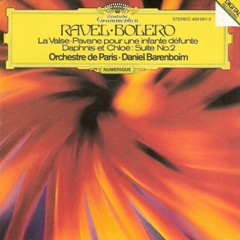111 Years of Deutsche Grammophon - CD 4
111 Years of Deutsche Grammophon - CD 4
Ravel: Bolero; Pavane; La Valse: Daphnis & Chloé Suite No.2

1 Boléro [17:30] 2 Pavane pour une infante défunte [7:41] 3 La Valse [13:14] Daphnis et Chloé, Suite No.2 4 1. Lever du jour [5:48] 5 2. Pantomime [7:06] 6 3. Danse générale [4:10] Michel Debost - flute Myron Bloom - horn Orchestre de Paris Daniel Barenboim
Boléro is a one-movement orchestral piece by Maurice Ravel (1875–1937). Originally composed as a ballet commissioned by Russian ballerina Ida Rubinstein, the piece, which premiered in 1928, is Ravel's most famous musical composition.[2] Before Boléro, Ravel had composed large scale ballets (such as Daphnis et Chloé, composed for the Ballets Russes 1909–1912), suites for the ballet (such as the second orchestral version of Ma Mère l'Oye, 1912), and one-movement dance pieces (such as La Valse, 1906–1920). Apart from such compositions intended for a staged dance performance, Ravel had demonstrated an interest in composing re-styled dances, from his earliest successes (the 1895 Menuet and the 1899 Pavane) to his more mature works like Le tombeau de Couperin (which takes the format of a dance suite).
Boléro epitomises Ravel's preoccupation with restyling and reinventing dance movements. It was also one of the last pieces he composed before illness forced him into retirement: the two piano concertos and the Don Quichotte à Dulcinée song cycle were the only compositions that followed Boléro. Pavane pour une infante défunte (Pavane for a Dead Princess) is a well-known piece written for solo piano by the French composer Maurice Ravel in 1899 when he was studying composition at the Conservatoire de Paris under Gabriel Fauré. Ravel also published an orchestrated version of the Pavane in 1910. A typical performance of the piece lasts between six and seven minutes. In addition to numerous recorded performances within the classical repertoire, the Pavane maintains a significant presence in popular music. In particular, the song "The Lamp Is Low" was adapted from it.
La valse, un poème choréographique pour orchestre (a choreographic poem), is a work written by Maurice Ravel from February 1919 until 1920 (premiered in Paris on 12 December 1920). It was conceived as a ballet but is now more often heard as a concert work. The idea of La valse began first with the title "Vienne", then Wien (French and German for "Vienna") as early as 1906, where Ravel intended to orchestrate a piece in tribute to the waltz form and to Johann Strauss II. An earlier influence from another composer was the waltz from Emmanuel Chabrier's opera Le roi malgré lui. In Ravel's own compositional output, a precursor to La valse was his 1911 Valses nobles et sentimentales, which contains a motif that Ravel reused in the later work. After his service in the French Army, Ravel returned to his original idea of the symphonic poem Wien. Ravel completely reworked his idea of Wien into what became La valse, which was to have been written under commission from Sergei Diaghilev as a ballet.
Daphnis et Chloé is a ballet with music by Maurice Ravel. Ravel described it as a "symphonie choréographique" (choreographic symphony). The scenario was adapted by Michel Fokine from an eponymous romance by the Greek writer Longus thought to date from around the 2nd century AD. Ravel began work on the score in 1909 after a commission from Sergei Diaghilev. It was premiered at the Théâtre du Châtelet in Paris by his Ballets Russes on June 8, 1912. The music, some of the composer's most passionate, is widely regarded as some of Ravel's best, with extraordinarily lush harmonies typical of the impressionist movement in music. Even during the composer's lifetime, contemporary commentators described this ballet as his masterpiece for orchestra. He extracted music from the ballet to make two orchestral suites, which can be performed with or without the chorus. The second of the suites, which includes much of the last part of the ballet and concludes with the "Danse generale", is particularly popular. When the complete work is itself performed live, it is more often in concerts than in staged productions.
